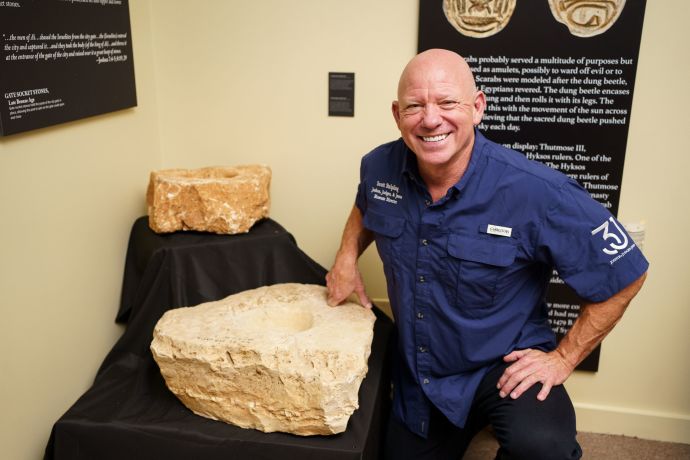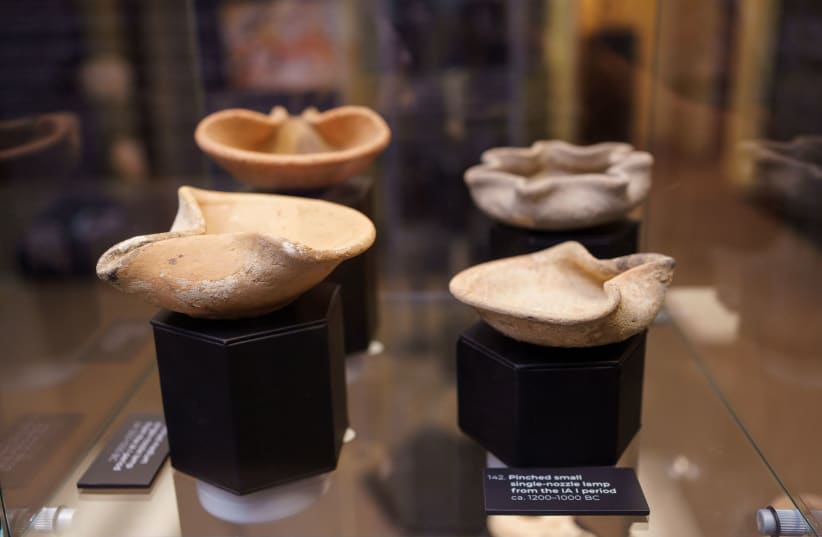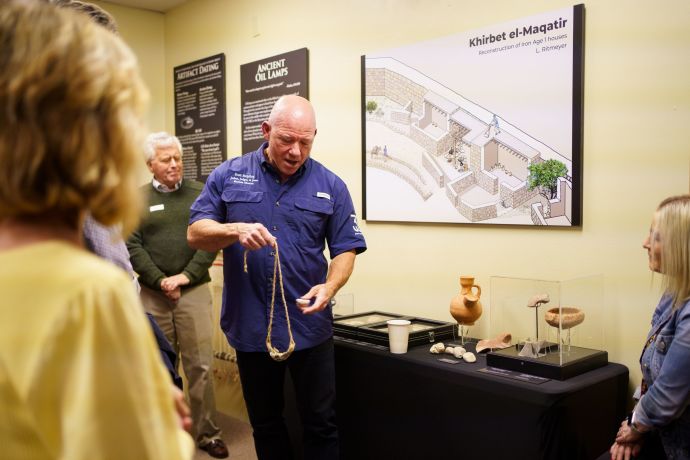The Bible Seminary in Katy Texas is hosting an exhibit of over 170 artifacts from Israel at their exhibit titled Joshua, Judges and Jesus.
The seminary decided to open the exhibit after Israel closed its skies for two years and Christian tourists were unable to visit the country.
“Israel has long been a destination for tourists and Bible enthusiasts, but with the current worldwide health crisis, people are unable to travel to the Land of the Bible,” Dr. Scott Stripling, provost and director of the Archaeology Institute at the seminary told The Jerusalem Post. “Since Houstonians cannot travel to Israel, TBS is bringing Israel – and the Bible, to Texas.”

Many of the artifacts on display were excavated by Stripling and TBS students enrolled in the Master of Arts in Biblical History and Archaeology program. The artifacts include tesserae from a mosaic floor; amphorae, an Egyptian scarab from the Pharoah of the Exodus; magical incantation bowls; alabaster and ivory pendants; lamps; weaponry; coins; stone bowls; cups; and gate socket stones from the Biblical city of Ai.
About half of the artifacts came from Khirbet el-Maqatir located nine miles north of Jerusalem, which biblical archeologists have identified as the Biblical city of Ai. The capture of the city by the Jews, believed to have taken place around 1400 BC, was described in the Book of Joshua, chapters 7-8.
According to the Book of Joshua, the City of Ai was conquered by the Israelites.
After an initial attempt failed due to a sin committed by an Israelite name Achan resulted in a demoralizing defeat, according to the Bible, a God-directed ambush led to the Israelites conquering the city. The king is captured and hanged on a tree until the evening. His body is then placed at the city gates and stones are placed on top of his body. The Israelites then burn Ai completely.
Then Joshua burned down Ai, and turned it into a mound of ruins for all time, a desolation to this day. (Joshua 8:28)
Stripling has suggested that Jesus could have visited the site on his way to Jerusalem and the city may in fact be Ephraim mentioned in John 11:53-54.
“Then, from that day on, they plotted to put Him to death. Therefore, Jesus no longer walked openly among the Jews, but went from there into the country near the wilderness, to a city called Ephraim, and there remained with His disciples.”
Jesus and the disciples stayed in Ephraim until his triumphal entry into Jerusalem.
“If anyone is interested in the Biblical text, the artifacts bring it into 3-D,” Stripling said. “It changes everything about how you relate to the text.”
Stripling gave the example of the story of one of the miracles of Jesus in the synoptic Gospels in which some men made an opening in the roof above Jesus and then lowered a paralytic man down.
“Well, what did a roof look like in biblical times?” Stripling asked. “We can show people what actual roof tiles from that time looked like. It gives people a real idea of what these biblical events looked like.”
Another part of the featured exhibit are the heavy limestone socket stones from the city gate.
“We have the socket stones from the gate of the city Ai, which is very different from what we know of as a gate today,” Stripling explained. “They were found on the north side of the city, which is exactly where the Bible says the gate of Ai was. If we had found the gate on the west, the east or the south, we would have known this was not the right place. But sure enough, it was on the north side — just as the Bible had indicated. So many things happened at the gates. That is where the elders sat.”
The scarab featured in the exhibit is from 15th century BC when the fortress was built and it is the only one of its kind that has been found in Israel. It was named the top biblical archaeological discovery by Christianity Today in 2013. Scarabs were popular amulets and impression seals, typically cut in the form of scarab beetles.
Other artifacts from the dig include some of the more than 1,300 coins found at the site. All but seven — two gold and five silver — are made of bronze. There is also an infant burial jar, sling stones used in combat, jewelry and oil lamps, among many other items.
Though not all archeologists believe that archeology findings can be used to prove the biblical narrative, and some even say that it disproves the Bible, Stripling said his work as an archeologist has complemented his faith.“My work in archaeology in Israel has affected me profoundly as a believer,” Stripling said.
“Our goal isn’t to prove the Bible through archaeology,” Stripling emphasized. “In the process of doing good scientific archaeology in Israel, how can you not prove the Bible? We are uncovering evidence of the events the biblical text describes.
“My desire is that people consider that when we read the Bible, we are dealing with real people and real events,” he continued. “This is not mythology. It is not just a metaphor. Through archaeology, we have found what the Bible led us to expect to find.
“Archaeology helps establish our Christian roots in Judaism, in the very soil of Israel,” Stripling concluded.The artifacts are on loan from the Civil Authority of Judea and Samaria through the Israeli government and the US State Department.
Stripling is the director of excavations for the Associates for Biblical Research, a Christian organization that brings together Biblical research and archaeology to mutually advance both disciplines, at ancient Shiloh (2017 to present). Previously, Stripling directed the ABR excavations at Khirbet el-Maqatir, served as Field Supervisor at Tall el-Hammam in Jordan, and as a supervisor of the Temple Mount Sifting Project in Jerusalem.


